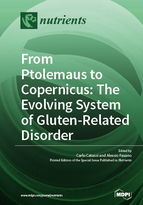From Ptolemaus to Copernicus: The Evolving System of Gluten-Related Disorders
A special issue of Nutrients (ISSN 2072-6643).
Deadline for manuscript submissions: closed (31 October 2016) | Viewed by 196433
Special Issue Editors
2. Italian Society for Pediatric Gastroenterology, Hepatology and Nutrition (SIGENP), Milan, Italy
Interests: celiac disease; gluten-related disorders; gluten sensitivity; pediatric gastroenterology; pediatric nutrition
Special Issues, Collections and Topics in MDPI journals
Interests: gut microbiome and nutrition; gut permeability; intestinal mucosal immunology; celiac disease and other gluten related disorders; autism, autoimmune diseases
Special Issues, Collections and Topics in MDPI journals
Special Issue Information
Dear Colleagues,
Gluten is the major protein of wheat and other cereals (rye and barley), which is responsible for triggering celiac disease (CD) in genetically predisposed individuals. Until a few years ago, CD was the major (if not the only) well-known gluten-related disorder. However, in recent years it has become clear that gluten proteins may activate different pathological mechanisms, leading to a wide spectrum of human diseases, including non-celiac gluten sensitivity (NCGS), gluten ataxia, neuro-psychiatric disorders, and may others. Conceptually, we have therefore moved from a Ptolemaic to a Copernican system, i.e., CD is no longer the “center of the universe”, but is just one of the possible worlds of gluten intolerance. Many other gluten planets do indeed exist and deserve the attention of researchers and clinicians alike.
Although different gluten-related disorders show specific epidemiological, pathophysiological, and clinical aspects, these conditions share a trigger and treatment, the gluten-free diet. For a very long time, awareness of these disorders has been limited and, therefore, the epidemiology of gluten-related disorders is still a “work in progress”. Current research strives to clarify the boundaries between these entities, their disease mechanisms, and how a proper diagnosis can be implemented.
Nearly 25% of Americans (many more than the projected three million CD patients in the U.S.) are reducing or cutting gluten from their diets. This remarkable trend in the general population reflects the misconception that gluten can be harmful for everybody and, therefore, should be avoided to stay healthy, to lose weight, or even to prevent severe diseases.
This Special Issue of Nutrients will contain contributions from leading experts in the field of gluten-related disorders, which will help to dissipate this confusion by sharing their evidence-based science, which will help the reader to distinguish facts from fantasies.
Prof. Dr. Carlo Catass
Prof. Dr. Alessio Fasano
Guest Editors
Manuscript Submission Information
Manuscripts should be submitted online at www.mdpi.com by registering and logging in to this website. Once you are registered, click here to go to the submission form. Manuscripts can be submitted until the deadline. All submissions that pass pre-check are peer-reviewed. Accepted papers will be published continuously in the journal (as soon as accepted) and will be listed together on the special issue website. Research articles, review articles as well as short communications are invited. For planned papers, a title and short abstract (about 100 words) can be sent to the Editorial Office for announcement on this website.
Submitted manuscripts should not have been published previously, nor be under consideration for publication elsewhere (except conference proceedings papers). All manuscripts are thoroughly refereed through a single-blind peer-review process. A guide for authors and other relevant information for submission of manuscripts is available on the Instructions for Authors page. Nutrients is an international peer-reviewed open access semimonthly journal published by MDPI.
Please visit the Instructions for Authors page before submitting a manuscript. The Article Processing Charge (APC) for publication in this open access journal is 2900 CHF (Swiss Francs). Submitted papers should be well formatted and use good English. Authors may use MDPI's English editing service prior to publication or during author revisions.
Keywords
- gluten-related disorders
- celiac disease
- non celiac gluten sensitivity
- gluten intolerance
- gluten-free diet








